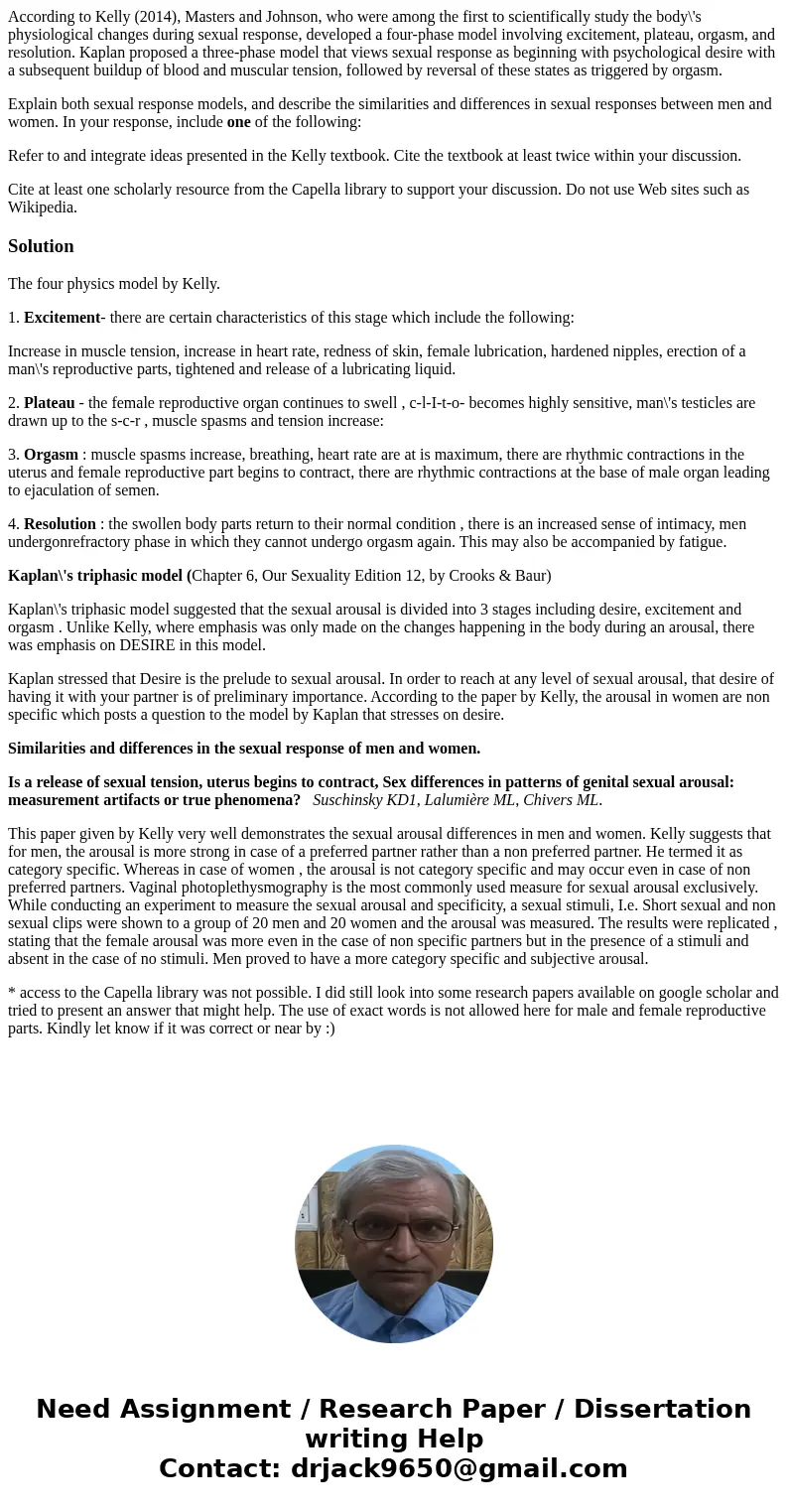According to Kelly 2014 Masters and Johnson who were among t
According to Kelly (2014), Masters and Johnson, who were among the first to scientifically study the body\'s physiological changes during sexual response, developed a four-phase model involving excitement, plateau, orgasm, and resolution. Kaplan proposed a three-phase model that views sexual response as beginning with psychological desire with a subsequent buildup of blood and muscular tension, followed by reversal of these states as triggered by orgasm.
Explain both sexual response models, and describe the similarities and differences in sexual responses between men and women. In your response, include one of the following:
Refer to and integrate ideas presented in the Kelly textbook. Cite the textbook at least twice within your discussion.
Cite at least one scholarly resource from the Capella library to support your discussion. Do not use Web sites such as Wikipedia.
Solution
The four physics model by Kelly.
1. Excitement- there are certain characteristics of this stage which include the following:
Increase in muscle tension, increase in heart rate, redness of skin, female lubrication, hardened nipples, erection of a man\'s reproductive parts, tightened and release of a lubricating liquid.
2. Plateau - the female reproductive organ continues to swell , c-l-I-t-o- becomes highly sensitive, man\'s testicles are drawn up to the s-c-r , muscle spasms and tension increase:
3. Orgasm : muscle spasms increase, breathing, heart rate are at is maximum, there are rhythmic contractions in the uterus and female reproductive part begins to contract, there are rhythmic contractions at the base of male organ leading to ejaculation of semen.
4. Resolution : the swollen body parts return to their normal condition , there is an increased sense of intimacy, men undergonrefractory phase in which they cannot undergo orgasm again. This may also be accompanied by fatigue.
Kaplan\'s triphasic model (Chapter 6, Our Sexuality Edition 12, by Crooks & Baur)
Kaplan\'s triphasic model suggested that the sexual arousal is divided into 3 stages including desire, excitement and orgasm . Unlike Kelly, where emphasis was only made on the changes happening in the body during an arousal, there was emphasis on DESIRE in this model.
Kaplan stressed that Desire is the prelude to sexual arousal. In order to reach at any level of sexual arousal, that desire of having it with your partner is of preliminary importance. According to the paper by Kelly, the arousal in women are non specific which posts a question to the model by Kaplan that stresses on desire.
Similarities and differences in the sexual response of men and women.
Is a release of sexual tension, uterus begins to contract, Sex differences in patterns of genital sexual arousal: measurement artifacts or true phenomena? Suschinsky KD1, Lalumière ML, Chivers ML.
This paper given by Kelly very well demonstrates the sexual arousal differences in men and women. Kelly suggests that for men, the arousal is more strong in case of a preferred partner rather than a non preferred partner. He termed it as category specific. Whereas in case of women , the arousal is not category specific and may occur even in case of non preferred partners. Vaginal photoplethysmography is the most commonly used measure for sexual arousal exclusively. While conducting an experiment to measure the sexual arousal and specificity, a sexual stimuli, I.e. Short sexual and non sexual clips were shown to a group of 20 men and 20 women and the arousal was measured. The results were replicated , stating that the female arousal was more even in the case of non specific partners but in the presence of a stimuli and absent in the case of no stimuli. Men proved to have a more category specific and subjective arousal.
* access to the Capella library was not possible. I did still look into some research papers available on google scholar and tried to present an answer that might help. The use of exact words is not allowed here for male and female reproductive parts. Kindly let know if it was correct or near by :)

 Homework Sourse
Homework Sourse